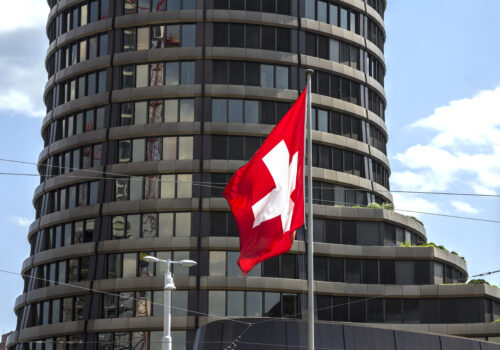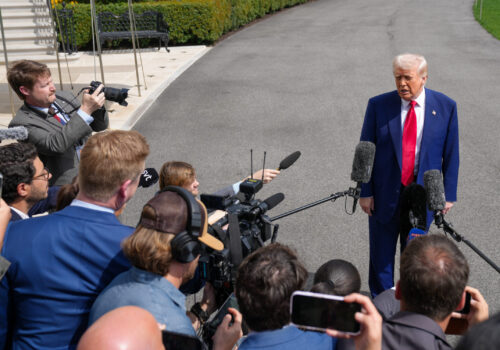The search for safe assets
The search for safe assets has become acute amidst economic uncertainty and financial market stresses triggered by the tariff war and heightened geopolitical tension. High-quality government bonds have played an important role as anchors in the portfolios of central banks’ reserve assets, as well as other large and long-term institutional investors such as pension funds and insurance companies. High-quality government bonds have also been in demand to serve as collateral in credit transactions, in part because Basel III financial regulations have incentivized banks to lend against collateral to reduce risk weights when calculating their capital requirements.
At the same time, the quality of government bonds issued by developed countries, mainly the United States, has been questioned. Developed countries face fiscal pressures reflecting demands for higher government spending on defense, infrastructure, and other needs, while their budget deficits and government debts are already at high levels.
The ensuing search for safe assets has come up against the fact that there are no obvious alternatives to US Treasuries. Efforts to deal with the problems of fiscal deterioration in major countries by diversifying safe asset portfolios could lead to market volatility, posing a risk to global financial stability.
US dominance in the global bond market
The global bond market is estimated to be about $140 trillion, dominated by the United States, which amounts to $55 trillion—or 39.3 percent of the total. The bulk of the US bond market is made up of US Treasury securities marketable to the public. These securities are worth $28.8 trillion, and amount to the biggest and most liquid bond market in the world. A total of $9 trillion, or 31.2 percent are held by foreigners and $4.2 trillion, or 14.6 percent, are held by the Federal Reserve. Together with intragovernment holding of US Treasuries totaling more than $7 trillion, US government debt has reached $36 trillion, or 124 percent of US gross domestic product (GDP)—doubling the debt-to-GDP ratio of 62 percent posted in 2007 prior to the global financial crisis.
Moreover, the US fiscal outlook has worsened. The administration’s budget package—named the One Big Beautiful Bill Act—has been approved by the House, and is currently under the Senate’s consideration. It makes the 2017 tax cuts permanent and, if enacted, would increase the $1.8 trillion budget deficit in 2024 by $2.4 trillion between 2026 and 2034. These estimates, provided by the Congressional Budget Office, would raise the amount of government debt in the process. The United States’ deteriorating budget deficit trajectory has prompted international investors to share concerns about the sustainability of US public finance, which could lead to upward pressure on yields to compensate for the higher perceived risk. This has been manifested by the fact that, since recent stock market turmoil following the announcement of reciprocal tariffs on April 2, 2025, yields on US Treasuries have risen by forty basis points. The US dollar also weakened by 4.2 percent. If international investors flock to US Treasuries as safe havens, Treasury yields would have risen and the US dollar would have become stronger.
No good alternatives to US Treasuries
The deterioration of the US fiscal outlook has put international investors, especially foreign central banks, in a quandary. There is no good alternative to US Treasuries as safe reserve assets. Other major countries have also been burdened with high budget deficits and public debt levels—albeit generally less acute than the United States. Those markets that have lower deficits are smaller and less liquid than the US Treasury market, making them less attractive as reserve assets.
The euro has been frequently mentioned as an aspirant to compete with the dollar—a point recently emphasized by Christine Lagarde, president of the European Central Bank (ECB). However, the public bond markets dominated by the euro are fragmented and collectively smaller than the US Treasury market. They are able to supplement but not replace US Treasuries.
The European Union (EU) has launched three programs to issue joint Eurobonds within its budgetary authority: SURE, a program to support employment during Covid-19, for up to €100 billion; NextGenerationEU, a stimulus package to grow Europe’s economy, for up to €712 billion; and the European Financial Stability Mechanism, which provides assistance to member states in financial distress, for up to €60 billion. To date, about €468 billion ($533 billion) worth of Eurobonds are outstanding—just big enough to be an attractive niche market segment.
The euro area (EA) member states have a combined government bond market of more than €10 trillion ($11.4 trillion), of which about 35 percent is held by the ECB and 22 percent is held by foreigners. Trading, especially by hedge funds, has concentrated on the German, French, Spanish, and Italian markets. However, the EA market is fragmented into national markets, each of which is shaped by different and often divergent domestic economic and fiscal circumstances.
The UK government (gilt) bond market is fairly substantial at £2.6 trillion ($3.5 trillion), with about 30 percent held by foreigners.
The Japanese Government Bond (JGB) market amounts to $7.8 trillion or 250 percent of Japan’s GDP. The Bank of Japan (BOJ) holds 52 percent of the JGB market due to its massive JGB purchases, though the BOJ has been scaling back its purchasing volume while Japan emerges from deflation. Along with prospects of substantial borrowing needs by the Japanese government, this has pushed up yields and stymied demand from foreign investors who already account for only 6.4 percent of the JGB market. Finally, the Chinese bond market—at $21.3 trillion—is the second biggest in the world after the US market. However, the bulk of the public bond segment of $14.4 trillion is in bonds issued through local government financing vehicles, which are fragmented and illiquid. Central government bonds only account for $3 trillion. Foreign investors take up only 7 percent of the Chinese government bond market. Overall, the lack of free convertibility of the renminbi and the closed capital account have rendered Chinese government bonds not completely suitable as safe assets for global central banks.
Some central banks have purchased substantial amounts of gold in recent years to hedge against economic uncertainty and geopolitical tension. This has helped push the price of gold up 42 percent over the past year to record highs around $3,300 per ounce. As a result, the average share of gold at market values in global centeral bank reserves has reached 15 percent. It’s unlikely that this share will continue to rise much further in future, given the limited supply of gold. The costs of holding it also include lack of interest earnings, storage and transportation costs, and the inconvenience in using gold as means of settling international transactions.
Conclusions
The deteriorating fiscal outlook of major countries, especially the United States, has made safe assets more difficult to find. Going forward, there will likely not be an effort to replace US Treasuries with other government bonds—there is simply no viable alternative. Instead, a trend toward diversification to better manage heightened sovereign and credit risks on what used to be thought of as risk-free assets is probable. More frequent portfolio restructuring and the substitution necessary for diversification measures would add to market uncertainty and volatility, at a time when both measures have already been elevated by the tariff war and geopolitical tension. This trend would increase risk to global financial stability.
In particular, the share of the US dollar and US assets, such as Treasury securities in global safe asset portfolios, will likely decline gradually over time as international investors move to diversify their portfolios. When looking at the composition of global central bank reserves, this development is consistent with the gradual decline of the dollar from 72 percent in 1999 to 57.8 percent in the fourth quarter of 2024. The trend was not in favor of any other major currency such as the euro, whose share has been stable around 19.8 percent in recent years, but to a variety of nontraditional reserve currencies. If the world’s central banks were to maintain a neutral allocation to US Treasury securities in their reserves portfolios, that would be 36 percent—the share of US Treasuries in the global government bond market totaling $80 trillion.
Hung Tran is a nonresident senior fellow at the Atlantic Council’s GeoEconomics Center and senior fellow at the Policy Center for a New South; and former senior official at the Institute of International Finance and International Monetary Fund
Related content

At the intersection of economics, finance, and foreign policy, the GeoEconomics Center is a translation hub with the goal of helping shape a better global economic future.



